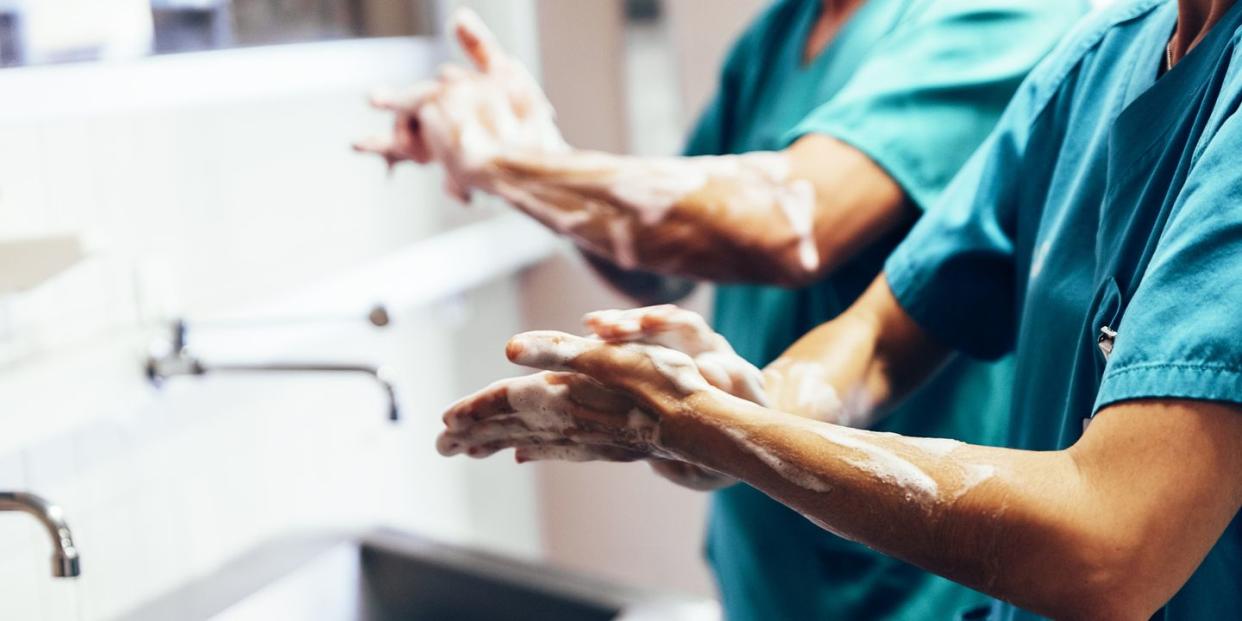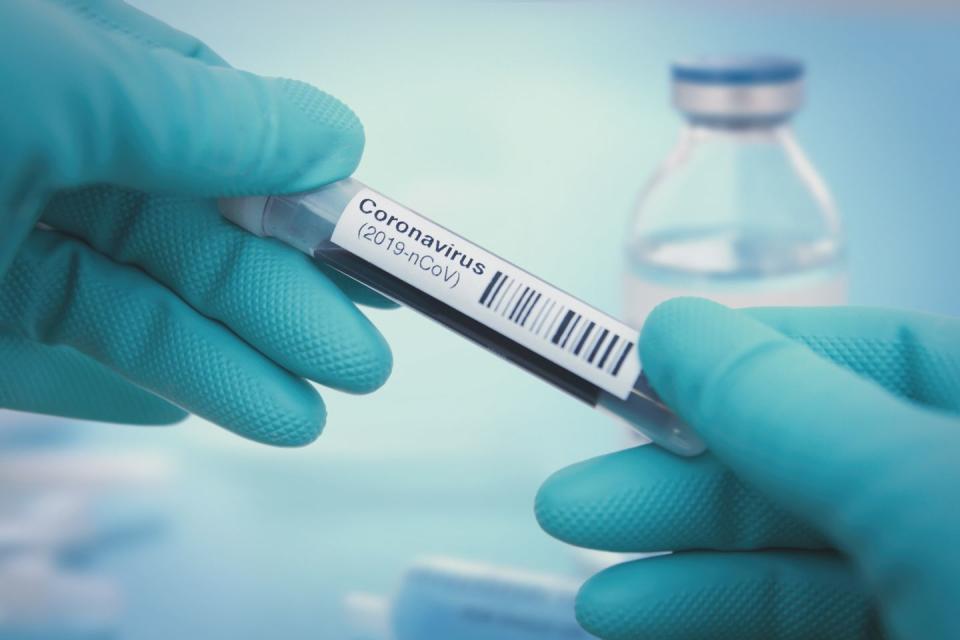A Long Island Doctor on Life Inside His ER: "The Whole Thing Is COVID"

Over the weekend, Governor Andrew Cuomo noted that Long Island is a new hot spot for coronavirus as New York tries to flatten the curve. "New York City is actually dropping as the number of cases in Long Island increases," he said during a press conference. Indeed, Nassau and Suffolk counties now have 13,000 and 15,000 cases respectively—edging closer to the widely reported outbreaks in Brooklyn (19,000+ cases) and Queens (23,000+ cases). We spoke with Dr. Andrew Mastanduono, an emergency physician at Northwell Southside Hospital in Long Island, to get a sense of what life is like in his ER right now.
Prevention.com: How is your workday different now compared to life before coronavirus?
Dr. Mastanduono: We have completely reorganized the logistics of our Emergency Department. It used to be organized where the lower acuity patients went to one area, the in- between patients went to another area, and the critically ill (which was the least common type of patient) went to a third smaller area. About a week or two ago, we reorganized it into respiratory complaints (likely COVID), non-respiratory complaints, and critically ill. Now, the whole thing is COVID. Almost every patient I see has some kind of a respiratory issue. Additionally, the number of critically ill patients has significantly increased from what we used to see. In the past we may have gone several days without intubating someone in our department. Now there are multiple patients per shift requiring a ventilator. All because of COVID.
Also, the guidelines, research, and the way we were treating COVID patients two weeks ago is different than a week ago. It's different than what we're doing now, and it's probably different than what we'll do next week.
Prevention.com: So much of what's in the media right now has to do with the shortage of masks and personal protective equipment (PPE). Where are you at on that front?
Dr. Mastanduono: The hospital’s done a pretty good job of being on top of the PPE situation. Ideally, you're supposed to have one mask and oneper patient. We don't have that luxury. The way we have it set up is you get one mask for the week unless you intubate a patient because that's a high-risk procedure. If you intubate a patient, then you're allowed to have a new mask. And anytime I've asked for something, I’ve had it, which has been good.
Prevention.com: That's great. And then how about your shifts?
Dr. Mastanduono: One of the big issues we've been having is when one of us gets sick, they go out and other doctors have to cover for them. If it is from COVID, he or she may be out for 1-3 weeks or even more. So some of us are being asked to come in and work extra hours just because we need the doctor coverage if somebody is sick, either with COVID or something else.
Prevention.com: If someone reading this is experiencing COVID symptoms, when do you recommend they come to the ER versus staying home and trying to just self-isolate?
Dr. Mastanduono: It's a good question because everybody experiences being sick differently. We always joke about the man flu, right? People can experience illness within different extremes. Typically, our goal is to keep people out of the hospital. Because if you have COVID and you come to the hospital and you don't need to be there, you're exposing yourself to whatever germs might be in the hospital and then you're exposing the doctors, nurses, registration, techs, everybody to your illness when they treat you. So, if you don't need to be there, don’t be there.
Our recommendation is that if you feel extremely weak—like walking from one room to the other makes you very short of breath or weak or you're just having, at baseline, difficulty breathing—come in and get assessed because you might have progressed to a point where you need oxygen or breathing assistance. If you're just having fevers, a cough, and a little fatigue, take your temperature and treat with Tylenol. Try to stay home and isolate yourself. It's only if you really have respiratory distress (significant difficulty breathing) that you should come to the hospital. If you are not sick enough to be admitted to the hospital because you require extra oxygen, there’s typically nothing extra we're going to do for you. There are some medications we have been prescribing to our hospitalized COVID patients, but the recommendations for those have been continuously changing, and we usually do not prescribe them to patients being discharged home. Basically, if you can breathe on your own, you will likely be sent home with Tylenol and return precautions.
Prevention.com: Got it. So how do you assess who needs your help breathing?
Dr. Mastanduono: We use two assessments on that. One is somebody's respiratory rate, which is how many breaths they’re taking per minute. And the other is their oxygen saturation. So, measuring how much oxygen is in their blood. It’s very simple, you just put a little thing on their finger and if their oxygen saturation at rest is below a certain number, that's when we consider admitting you. Most people do get better with just a little extra oxygen that we give them through the nose or through a face mask, but some people don't get better even with that. Those are the people that are put on ventilators.

Prevention.com: Where are you at with COVID testing right now, as that's of course changing constantly.
Dr. Mastanduono: If you’re being admitted to the hospital, you’ll absolutely get tested. If you're a healthcare worker who has concerning symptoms, then we will test you, even if you are not sick enough to be admitted to the hospital. We need to make sure healthcare workers are healthy when they are with patients. If you live in a nursing home or an in-patient unit of any kind, we will test you so the staff who takes care of you knows how to treat you. But if you're, say, a 32-year-old female who has no medical problems and you're coming in with a fever and cough and your oxygen level is normal, in my community that means you probably have COVID, so I won't test you. Knowing if you have COVID or not won’t change any of our management because you are not sick enough to stay in the hospital, and you should already be social distancing. Having said that, some doctors are a bit more liberal with the testing; it’s usually up to the doctor's discretion. But most of us are being advised to save tests for health care workers and people being admitted.
Prevention.com: Given the testing shortage, have you experienced patients who become aggravated in the ER? How do you handle that?
Dr. Mastanduono: Yeah, I definitely have seen that. Anytime somebody comes to the emergency room, they're usually anxious, right? They're nervous that something bad is happening and they want to make sure they’re OK. But now, with all the hype and sensationalism in the news, they’re even more anxious. Oftentimes I will have the conversation with them that I just had with you—and explain what we're looking for, who is safe, and who is not safe. If they’re stable, I explain why that's the case and that it's OK for them to go home. Most people are reasonable and say, “I get it. I understand.” Some people, though, get very, very adamant about testing. They’ll say, “I want the test, I need the test,” and then I have to decide if I’m going to do it or not.
Prevention.com: How are you de-stressing, if at all, when you're not in the ER right now?
Dr. Mastanduono: Well, we have a new dog. My wife and I got him right before all this started happening, so playing with the dog has a way of taking my mind off of things. I do most of the cooking at home, and there’s a lot more cooking since we can’t go out. Basically, things that are not medical. I'll turn the news off or watch something that is very much not health or news-related just to unplug.
Prevention.com: How old is the puppy?
Dr. Mastanduono: He’s three-and-a-half months.
Prevention.com: A puppy is a great way to de-stress.
Dr. Mastanduono: It's a great way to de-stress—unless he’s peeing on the floor or chewing things he’s not supposed to.
Prevention.com: I should say a potty-trained puppy.
Dr. Mastanduono: Yeah, I think if he were maybe two months older, it would be a little bit better, but it definitely helps.
Prevention.com: Last question, how has this pandemic changed you so far as a physician? What do you feel like you're going to take away from it?
Dr. Mastanduono: I think two things. One, ER doctors usually have a "go with the flow" personality. Living in the moment and tackling the unknown is one of the things that draws a lot of us to emergency medicine—and doing everything we can to help our patients and adapt to changing situations. But this is to another extreme. So, I think this has taught me how to be a little bit more flexible and a little less rigid since the guidelines are constantly changing.
The other thing is communication—amongst our team, this has made us touch base with our nurses, techs, and administrators multiple times per shift to make sure we're all on the same page. And communication with our patients and their families. Something that used to be very easy—you just kind of pop into a room or as you're passing by and say, Hey, how’re you feeling? We could do that very quickly before. Now you've got to go into the room, you have to put your mask on, you have to put a gown on, you can't get too close to the patient, you’ve got to call their family since they’re no longer at the bedside due to visitation restrictions. So that communication has significantly changed. I have to put more work into something that used to be so easy. But it's worth it.
Like what you just read? You’ll love our magazine! Go here to subscribe. Don’t miss a thing by downloading Apple News here and following Prevention. Oh, and we’re on Instagram too.
You Might Also Like

